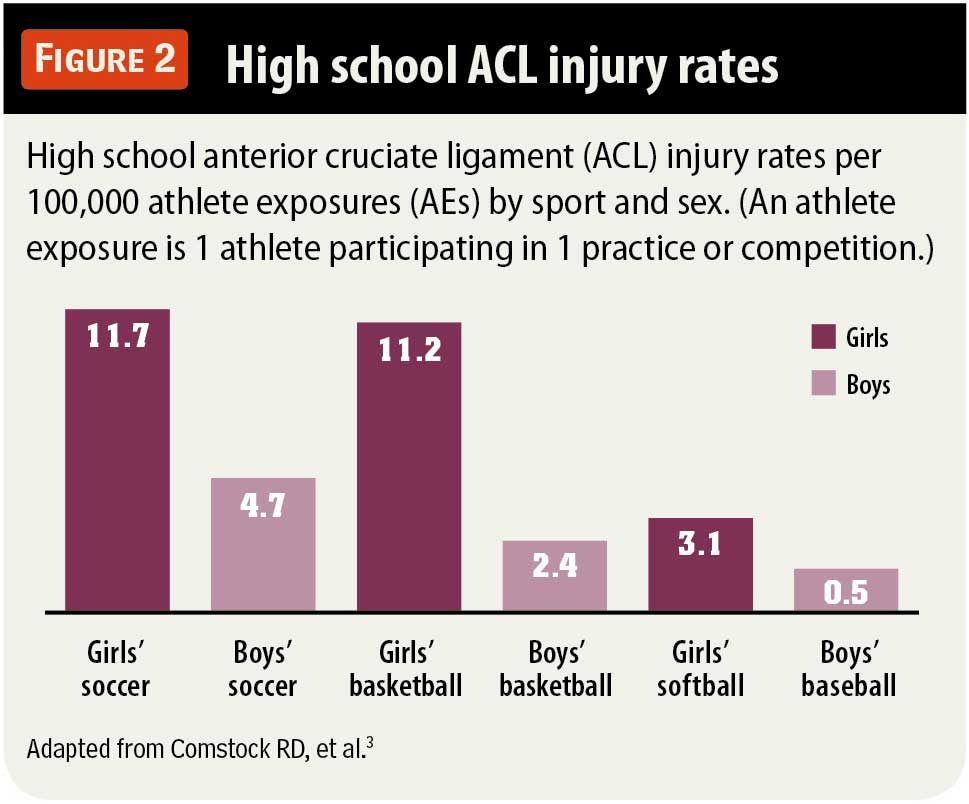ACL injury rates in women athletes have come under increased scrutiny, particularly in light of recent studies that reveal alarming disparities compared to their male counterparts. Research indicates that female athletes suffer from ACL tears at rates 1.7 times higher than males, prompting questions about the underlying causes. Many traditional narratives attribute this higher ACL injury rate to biological differences, such as hormonal factors and structural variations in the female body. However, a recent study challenges these notions, shedding light on the influence of factors like team roster sizes, which can significantly impact women athletes injury rates. Understanding the broader context of ACL tear risk factors is essential for developing effective sports injury prevention strategies that take into account gender differences in sports.
The discussion surrounding knee injuries, particularly anterior cruciate ligament (ACL) tears, has highlighted critical issues affecting female athletes. Incidents of ACL injuries have been noted to vary significantly between genders, leading researchers to delve into the potential causes behind this phenomenon. Various studies have explored not only the biological factors influencing women athletes but also the social structures and resources available to them. By analyzing the unique dynamics of injury rates, it’s evident that a multifaceted approach is required to address the nuances of sports injuries in women. Addressing these disparities is vital for fostering a safer and more equitable environment in sports.
Understanding ACL Injury Rates in Women Athletes
The anterior cruciate ligament (ACL) injury rates among women athletes have garnered significant attention over the years, with recent studies indicating that female athletes are 1.7 times more likely to suffer from ACL injuries compared to their male counterparts. This striking statistic highlights the need to investigate ACL injury rates in women athletes not just from a biological perspective, but also through the lens of social and environmental variables. The predominant narrative attributing these injuries solely to hormonal cycles and anatomical differences has been increasingly challenged by researchers, leading to a deeper understanding of the multifaceted nature of sports injuries.
Recent findings have shown that misconceptions surrounding ACL injury comparison between male and female athletes can stem from a biased interpretation of certain metrics used in sports science. By focusing on ‘athlete-exposures,’ researchers have uncovered that women typically experience injury risks that are not appropriately reflected in traditional data analysis methods. The lack of individualized assessments fails to capture the unique circumstances surrounding women’s sports participation, which often includes smaller teams and less funding. Therefore, discussions about ACL injury rates must consider these critical social and economic factors to create a more accurate picture.
Frequently Asked Questions
What are the ACL injury rates in women athletes compared to men?
Research indicates that ACL injury rates in women athletes are approximately 1.7 times higher than those of their male counterparts, highlighting significant gender differences in sports injury rates.
What factors contribute to the higher ACL injury rates in women athletes?
Higher ACL injury rates in women athletes can be attributed to a combination of social factors and biological differences, including smaller team sizes, lower training hours compared to competition time, and differences in athletic exposure metrics.
How do ACL injury comparison metrics differ across genders in sports?
ACL injury comparison metrics often fail to account for the unique conditions faced by women athletes, such as fewer resources and smaller teams, which can lead to misleading conclusions regarding injury rates between genders.
What is the importance of sports injury prevention in reducing ACL injuries among women athletes?
Sports injury prevention strategies, tailored for women athletes, are crucial in addressing the high ACL injury rates. Improved training, access to quality facilities, and conditioning can mitigate risks associated with ACL tears.
What are the key ACL tear risk factors specific to women athletes?
Key ACL tear risk factors for women athletes include hormonal influences, anatomical differences, and the impact of underfunding in women’s sports, which limits access to training resources and competitive opportunities.
How does athlete exposure impact ACL injury rates in women athletes?
Athlete exposure metrics, which often underestimate individual athlete participation, reveal that women athletes face higher ACL injury risks due to playing in smaller teams and spending less time in active competition due to resource disparities.
Why is it essential to reevaluate how ACL injury rates are calculated for women athletes?
Reevaluating ACL injury rate calculations is essential to account for factors such as training versus competition time and individual athlete exposures, as these factors can significantly alter perceptions of risk and inform better prevention strategies.
What role does underfunding play in ACL injury rates among women athletes?
Underfunding of women’s sports leads to fewer resources, less training time, and higher player-sharing, all of which contribute to increased ACL injury rates when compared to better-funded male teams.
| Aspect | Men | Women |
|---|---|---|
| Roster size-based Athlete Exposures (AEs) | 28 | 25 |
| Participant-based Athlete Exposures (AEs) | 19 | 17 |
| Player-hours | 6 | 6 |
| Injury rate per 100 roster-based AEs | 3.6 | 4.0 |
| Injury rate per 100 participant-based AEs | 5.3 | 5.9 |
| Injury rate per 100 player-hours | 16.7 | 16.7 |
| Injury risk per team member | 0.036 | 0.040 |
| Injury risk per participant | 0.053 | 0.059 |
Summary
ACL injury rates in women athletes are notably higher compared to their male counterparts due to a combination of biological and social factors. Recent studies have highlighted the limitations of traditional metrics used to measure these rates, suggesting that the focus on biological explanations alone fails to account for the disparities in training conditions and athlete exposure. Factors such as smaller team rosters and unequal funding contribute to a higher risk of ACL injuries in women athletes. To effectively address and reduce these injury rates, it’s crucial for sports science to incorporate a more comprehensive analysis of both biological and social influences on injuries.
